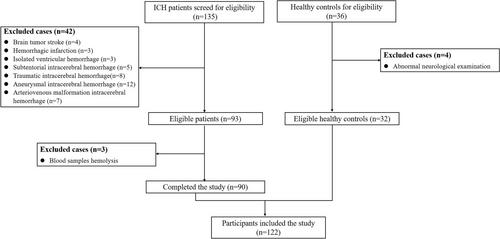Perihematomal edema (PHE) is one of the severe secondary damages following intracranial hemorrhage (ICH). Studies showed that blood–brain barrier (BBB) injury contributes to the development of PHE. Previous studies showed that occludin protein is a potential biomarker of BBB injury. In the present study, we investigated whether the levels of serum occludin on admission are associated with PHE volumes in ICH patients.
This cross-sectional study included 90ICH patients and 32 healthy controls.The volumes of hematoma and PHE were assessed using non-contrast cranial CT within 30 min of admission. Blood samples were drawn on admission, and the levels of baseline serum occludin were detected using enzyme-linked immunosorbent assay. Partial correlation analysis and multiple linear regression analysis were performed to evaluate the association between serum occludin levels and PHE volumes in ICH patients.
The serum occludin levels in ICH patients were much higher than health controls (median 0.27 vs. 0.13 ng/mL, p < 0.001). At admission, 34 ICH patients (37.78%) had experienced a severe PHE (≥30 mL), and their serum occludin levels were higher compared to those with mild PHE (<30 mL) (0.78 vs. 0.21 ng/mL, p < 0.001). The area under the receiver operating characteristics curve (ROC) of serum occludin level in predicting severe PHE was 0.747 (95% confidence interval CI 0.644–0.832, p < 0.001). There was a significant positive correlation between serum occludin levels and PHE volumes (partial correlation r = 0.675, p < 0.001). Multiple linear regression analysis showed that serum occludin levels remained independently associated with the PHE volumes after adjusting other confounding factors.
The present study showed that serum occludin levels at admission were independently correlated with PHE volumes in ICH patients, which may provide a biomarker indicating PHE volume change.



